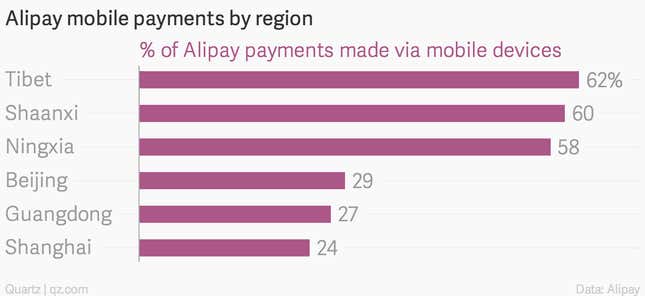New data from Chinese e-commerce giant Alibaba illustrate how fast China’s mobile payments industry is growing—and perhaps most interestingly, where that growth is taking place. According to a report from Alipay, the sister company that handles Alibaba’s online transactions, mobile payments accounted for 54% of all transactions for the first 10 months of this year, compared to just 22% last year.
This sea change is taking place largely in the country’s poorer and less populated regions, where few people own desktop computers, as well as among those with lower income and education levels. Almost half of China’s 857 million mobile internet users are in second- and third-tier cities. That usage is translating into mobile payments, according to Alipay, with mobile payments predominating in remote western regions like Tibet.

Online shopping is driving much of the transition. E-commerce is still growing fast in China’s inland provinces where households are growing wealthier and, with limited shopping selections, are coming to rely on online stores. In the Tibetan cities of Lhoka and Shigatse, average online spending has increased 600 times and 145, respectively, over the past decade, according to Alipay’s report. Online shoppers in more remote parts of China are also managing to outspend their wealthier counterparts in Shanghai and Beijing: Residents in Yiwu County in the western autonomous region of Xinjiang spent the most of any other county, an average of 65,1260 ($10,585) per capita, according to Alipay.
